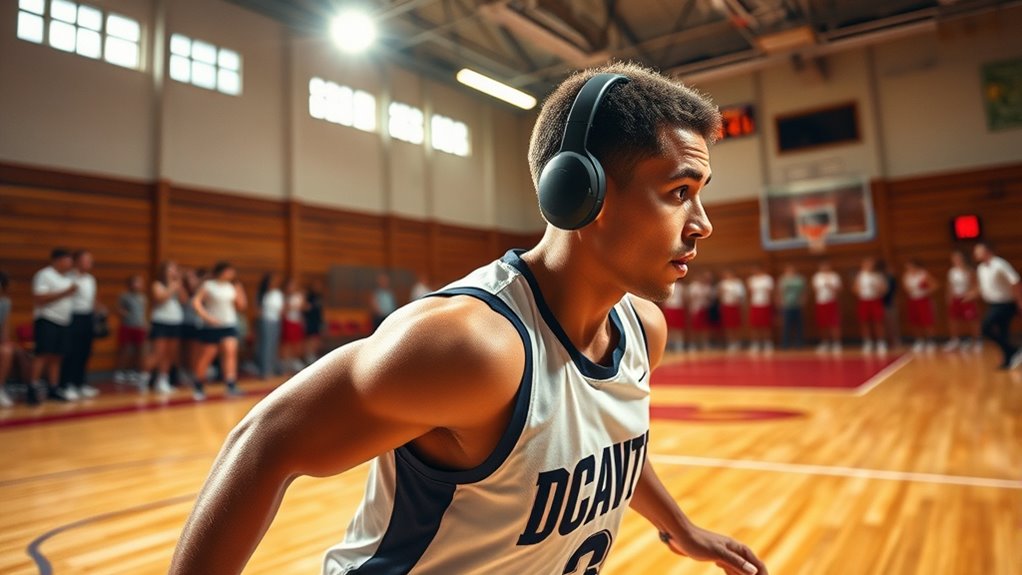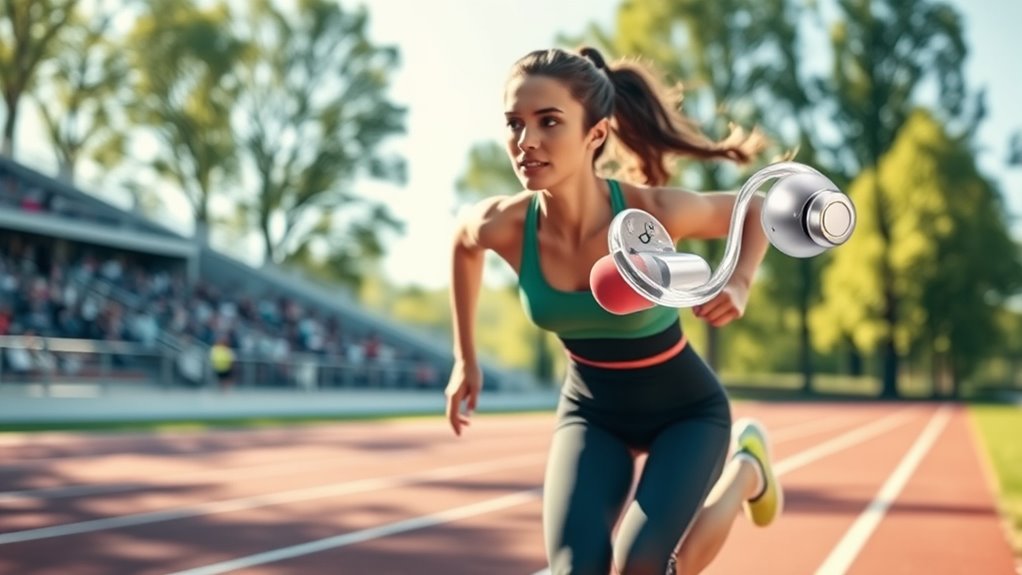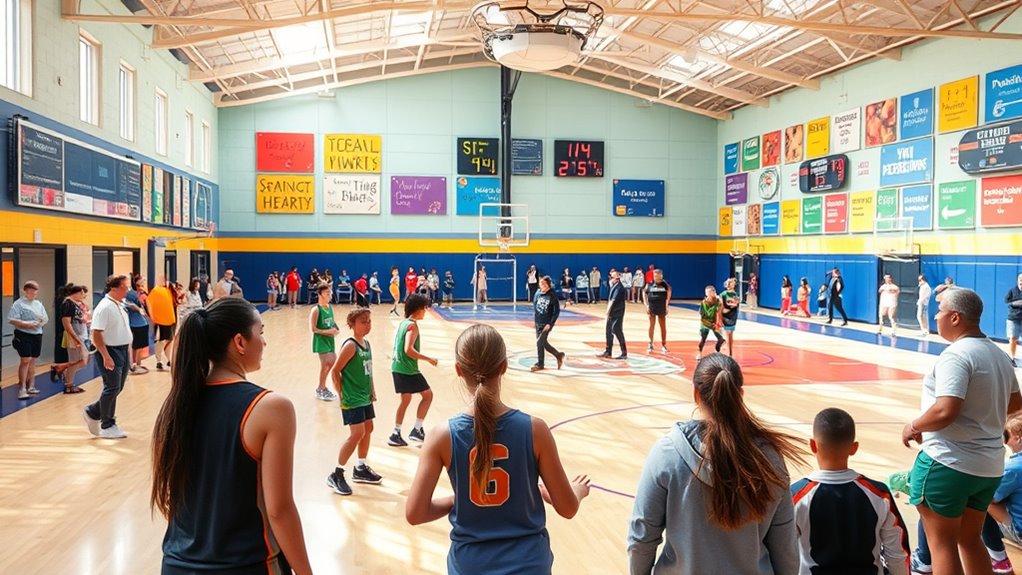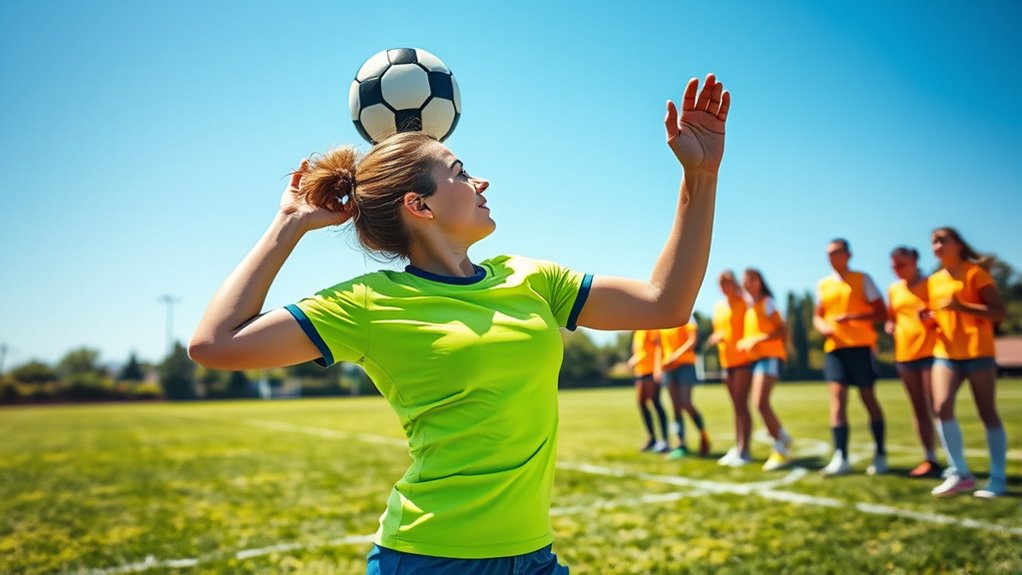If you have hearing loss, staying safe and competitive in sports is possible by using proper communication methods, like visual signals and tactile alerts, and choosing hearing protection that balances noise reduction with awareness. Be mindful of noise exposure in loud environments and get regular hearing checks to prevent further damage. Adapt your gear and advocate for inclusive facilities to support your participation. To learn more about maintaining safety and performance, keep exploring how you can stay in the game safely.
Key Takeaways
- Use visual cues, hand signals, and tactile alerts to communicate effectively during sports with hearing loss.
- Wear appropriate hearing protection to prevent noise-induced damage in loud stadiums or events.
- Regularly maintain hearing aids and monitor hearing health to detect early signs of damage.
- Adapt sports gear with visual or tactile features to accommodate hearing impairments safely.
- Educate teammates and coaches on effective communication methods to ensure safety and inclusion.
Understanding Hearing Loss and Its Impact on Sports Participation

Hearing loss can considerably affect your ability to participate in sports, as it impacts communication, balance, and spatial awareness. When your hearing isn’t sharp, you might miss crucial cues from teammates or game sounds, reducing your reaction time. Wearing hearing aids can help you stay alert and improve your understanding of your environment, but it’s essential to prioritize sports safety. Properly fitted hearing aids can prevent damage during physical activity and ensure clear sound transmission. Keep in mind that hearing loss may also affect your balance, making sports more challenging and increasing injury risk. Understanding how hearing loss influences your sports performance helps you take proactive steps, like using hearing aids and practicing safety measures, to stay engaged and safe on the field. Additionally, the contrast ratio of your hearing aids can influence how well you perceive sounds in varying environments, impacting your overall awareness during sports activities.
Recognizing the Risks of Noise Exposure in Sports Environments

Exposure to loud noises during sports activities can pose significant risks to your hearing health if you’re not aware of them. High-impact environments, such as stadiums, concerts, or even noisy equipment, can cause irreversible hearing damage. Recognizing these risks helps you take proactive steps to protect your hearing safety. You might not realize that cheering crowds, engine noises, or amplified music can all contribute to noise exposure. To stay in the game, consider using ear protection when exposed to loud sounds. Understanding the sources of noise is essential for preventing hearing loss and maintaining your overall well-being. Here’s a quick overview:
| Noise Source | Potential Risk |
|---|---|
| Stadium crowds | Hearing fatigue, damage |
| Loud music at events | Hearing loss |
| Equipment noise | Temporary or permanent damage |
| Amplified announcements | Hearing safety concern |
Being aware of and managing noise exposure levels is crucial for safeguarding your hearing health in sports settings.
Selecting the Right Hearing Protection for Active Athletes

Choosing the right hearing protection means considering how well it reduces noise and how comfortable it feels during activity. You need gear that fits securely without causing discomfort or distraction. When selecting, balance noise reduction with comfort to stay alert and protected on the field. Additionally, selecting appropriate protective gear can help prevent noise-induced hearing loss over time.
Noise Reduction Capabilities
Are you aware of how different hearing protection options can effectively reduce noise levels during athletic activities? Choosing the right ear protection depends on its noise reduction capabilities. Some ear protection, like foam earplugs, offers high noise reduction, blocking out loud sounds completely, which is ideal for loud environments. Others, like custom-molded ear protection, provide a balance of noise reduction while still allowing you to hear important sounds, such as teammates or coaches. Consider the noise levels you’ll encounter during your sport and select ear protection that minimizes harmful sound exposure without compromising situational awareness. Effective noise reduction helps protect your hearing while keeping you engaged in the game. Always evaluate the protection’s noise reduction rating (NRR) to find the best fit for your activity.
Comfort and Fit
When selecting hearing protection for active sports, comfort and fit are essential to guarantee you wear it consistently and effectively. Proper earplug comfort ensures you forget you’re even wearing protection during intense activity. Fit customization allows you to create a secure seal, preventing distractions and noise leakage. To visualize, consider these options:
| Earplug Type | Comfort Level | Fit Customization |
|---|---|---|
| Foam Earplugs | Moderate | Limited |
| Silicone Inserts | High | Adjustable |
| Custom Molded Earplugs | Superior | Fully tailored |
Choosing the right fit means you’ll stay focused on your game without discomfort or constant adjustment. Prioritize comfort and fit to maximize hearing protection and stay in the game safely. Additionally, understanding the importance of active listening and empathy can help you communicate effectively with your coach or teammates about any discomfort or specific needs related to your hearing protection.
Communicating Effectively With Teammates and Coaches

To communicate effectively with your teammates and coaches, using visual cues can make a big difference. Make sure your messages are clear and confirm understanding to avoid confusion. This approach helps guarantee everyone stays on the same page, even when hearing isn’t reliable. Additionally, incorporating targeted skincare like pimple patches can support your skin health during intense physical activity, reducing breakouts and irritation.
Use Visual Cues
Since hearing loss can make verbal communication challenging, using visual cues becomes essential for effective teamwork. Non-verbal signals like hand gestures, facial expressions, and body language help you stay connected during play. These visual cues improve understanding, especially when sound isn’t an option. Make eye contact with teammates and coaches to confirm messages. Using visual communication methods can significantly enhance coordination and safety on the field. Make sure to practice and familiarize yourself with these cues to ensure clear understanding during games. Use a simple table to clarify communication methods:
| Visual Cues | Purpose |
|---|---|
| Hand signals | Indicate plays or directions |
| Facial expressions | Show encouragement or alertness |
| Body language | Convey readiness or need for attention |
Confirm Messages Clearly
How can you guarantee your messages are understood clearly during sports activities? First, speak clearly and at a moderate pace, making sure your teammates and coaches are paying attention. Confirm messages by asking for feedback or repeating key instructions. If you wear a hearing aid, regular hearing aid maintenance ensures excellent sound quality, preventing miscommunication. Clear communication helps prevent sports injuries by ensuring everyone understands plays and safety signals. Use visual cues alongside verbal messages to reinforce instructions, especially in noisy environments. Always check that your communication methods are effective before the game starts. Staying proactive with hearing aid maintenance and confirming messages reduces the risk of misunderstandings, keeping you safe and in control while you focus on the game. Additionally, understanding home furnishings can improve your comfort and safety during rest and recovery after sports activities.
Adapting Sports Equipment and Strategies for Hearing-Impaired Players

Adapting sports equipment and strategies is essential for creating an inclusive environment for hearing-impaired players. You can modify sports gear to include visual cues, such as LED lights signaling game signals or whistles. Using effective communication methods, like hand signals or vibration alerts, helps players stay engaged and informed. To visualize equipment adaptations, consider this table:
| Traditional Equipment | Adapted Equipment |
|---|---|
| Whistles for signals | Vibrating wristbands |
| Verbal instructions | Visual cue cards or lights |
| Auditory alarms | Flashing LED indicators |
| Standard sports gear | Custom gear with visual or tactile features |
Implementing these strategies guarantees everyone can participate fully, making the game safer and more enjoyable for hearing-impaired players. Additionally, understanding hearing loss and its impact can help coaches develop more effective communication plans.
Advocating for Inclusive and Hearing-Friendly Sports Facilities

Creating inclusive and hearing-friendly sports facilities is essential for ensuring that everyone has equal opportunities to participate and enjoy physical activity. Thoughtful sports facility design should prioritize hearing accessibility, incorporating features like visual alert systems, sound-absorbing materials, and clear signage. Meeting accessibility standards guarantees that facilities accommodate hearing-impaired athletes, coaches, and spectators effectively. Advocating for these changes involves engaging with community stakeholders, policymakers, and facility managers to highlight the importance of hearing-friendly environments. By promoting standards that address acoustic design and visual cues, you help create spaces where all athletes feel supported and safe. Incorporating hearing-friendly features can significantly improve communication and safety during sports activities. Ultimately, inclusive sports facilities foster participation, boost confidence, and help break down barriers for individuals with hearing loss.
Monitoring Hearing Health and Recognizing Signs of Further Damage

Maintaining regular hearing health checks is essential to detect any early signs of damage and prevent further deterioration. Monitoring your hearing helps you stay in the game and prioritize injury prevention. Pay attention to these signs:
- Sudden decrease in hearing ability, especially after loud events or sports.
- Ringing or buzzing in your ears, which may indicate stress on your auditory system.
- Difficulty understanding speech or increased sensitivity to noise.
- Awareness of changes in hearing can also help identify the impact of noise-induced hearing loss and encourage protective measures.
Resources and Support Systems for Athletes With Hearing Loss

Fortunately, there are a variety of resources and support systems available to help athletes with hearing loss succeed in their sports and everyday lives. These include specialized coaching, adaptive technologies, and mental health awareness programs that address emotional wellbeing. Support groups connect you with others facing similar challenges, fostering a sense of community. Nutrition strategies can boost energy and focus, essential for peak performance. Here’s a visual of some key resources:
| Support System | Description |
|---|---|
| Hearing Assistive Devices | Improve communication during training and competitions |
| Mental Health Programs | Focus on emotional resilience and stress management |
| Adaptive Sports Clubs | Connect with athletes sharing similar experiences |
| Nutrition Strategies | Enhance energy and recovery |
| Support Networks | Offer emotional and practical guidance |
Frequently Asked Questions
How Can I Tell if My Hearing Loss Is Worsening From Sports Activities?
To tell if your hearing loss is worsening, pay attention to signs to monitor, like increased difficulty hearing conversations, ringing, or muffled sounds. Keep track of any new or worsening symptoms. It’s important to schedule regular hearing health check-ups with an audiologist, especially if you notice changes. Prompt assessments help catch issues early, so you can take steps to protect your hearing and stay in the game safely.
Are There Specific Sports More Suitable for Athletes With Hearing Impairments?
Some sports are more suitable for athletes with hearing impairments because they often rely less on auditory cues. You can consider activities that use adaptive equipment, such as visual signals or tactile feedback, to enhance communication. Non-verbal communication becomes key, so sports like tennis, swimming, or track are great options. These choices help you stay engaged and safe while enjoying the game without relying heavily on hearing.
Can Hearing Aids Interfere With Sports Performance or Safety Equipment?
Imagine your hearing aids turning into wild, unpredictable devices on the field! Usually, they don’t interfere with sports safety gear if you keep up with hearing aid maintenance. Properly fitted hearing aids stay snug, preventing distractions or accidents. Just guarantee you choose durable, sports-friendly safety gear designed for active use. Regular checks can keep your hearing aids in top shape, so you stay safe and fully aware during every game.
What Legal Rights Protect Athletes With Hearing Loss in Competitive Sports?
You have legal rights that protect you from disability discrimination in sports. Laws like the Americans with Disabilities Act (ADA) require that sports organizations provide legal accommodations to athletes with hearing loss, ensuring fair competition. These protections help you access necessary modifications or support, so you can participate safely and equitably, without facing discrimination or exclusion based on your hearing impairment.
How Can I Find Local Sports Programs Accommodating Hearing-Impaired Athletes?
Did you know that many local sports programs now offer inclusive options for hearing-impaired athletes? To find them, search online for adaptive equipment and communication strategies tailored for your needs. Contact community centers, specialized sports clubs, or organizations like the Hearing Loss Association of America. They often have resources and connections to programs that promote safe and enjoyable participation, ensuring you stay active and competitive in your favorite sports.
Conclusion
By taking proactive steps and staying mindful of your hearing health, you can continue enjoying sports without missing a beat. With the right protection and communication, you’ll keep the rhythm of the game alive. Remember, the key is to listen carefully to your body and team, gently guiding yourself toward safer, more inclusive play. Stay aware, stay prepared, and let your passion for sports shine—your hearing can still be part of the winning team.











